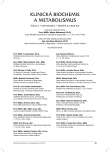-
Medical journals
- Career
The verification of the applicability of NPHS2/SYNPO ratio for diagnosis of FSGS and MCD
Authors: M. Šafaříková 1,2; E. Pazourková 2; A. Hořínek 1; J. Reiterová 1,2; D. Maixnerová 2; E. Honsová 3; J. Zadražil 4; J. Štekrová 1; M. Kohoutová 1; V. Tesař 2
Authors‘ workplace: Ústav biologie a lékařské genetiky, 1. lékařská fakulta UK v Praze a Všeobecná fakultní nemocnice v Praze 1; Klinika Nefrologie, 1. lékařská fakulta UK v Praze a Všeobecná fakultní nemocnice v Praze 2; Institut klinické a experimentální medicíny v Praze 3; III. Interní klinika, Lékařská fakulta Univerzity Palackého v Olomouci a Fakultní nemocnice v Olomouci 4
Published in: Klin. Biochem. Metab., 24, 2016, No. 2, p. 63-66
Overview
Objective:
The aim of this study was the verification of the applicability of NPHS2/SYNPO ratio for diagnosis of focal segmental glomerulosclerosis (FSGS) and minimal change disease (MCD) in Czech patients and identification of new markers for distinguishing between MCD and FSGS.Material and methods:
Our study was performed on 24 samples from patients with FSGS and MCD. Gene expressions were determined using relative quantitative real-time PCR and TaqMan® Array Micro Fluidic Cards and normalized to the reference gene GAPDH.Results and conclusion:
Our results did not find any significant difference in the podocin/synaptopodin ratio and in any other studied genes between FSGS and MCD.Keywords:
FSGS, MCD, gene expressions, quantitative real-time PCR.
Sources
1. Ryšavá, R., Tesař, V., Merta, M. Nefrotický syndrom. Interní med., 2005, 7, 3, p. 131–134.
2. Becker, D. J. Minimal change disease. Nephrology Rounds, 2008, 34, p. 111-34.
3. Korbet, S. M., Schwartz, M. M., Lewis, E. J. Primary Focal Segmental Glomerulosclerosis: Clinical Course and Response to Therapy, Am. J. Kidney Dis., 1994, 23, 6, p. 773-783.
4. D’Agati, V. D., Fogo, A. B., Bruijn, J. A., Jennette J. C. Pathologic classification of focal segmental glomerulosclerosis: a working proposal. Am. J. Kidney Dis., 2004, 43, 2, p. 368-382.
5. Brown, E. J., Schlöndorff, J. S., Becker, D. J. Mutations in the formin gene INF2 cause focal segmental glomerulosclerosis, Nat. Genet., 2010, 42, 1, p. 72-76.
6. Pavenstädt, H., Kriz, W., Kretzler, M. Cell biology of the glomerular podocyte. Physiol. Rev., 2003, 83, 1, p. 253-307.
7. Howie, A. J. Pathology of minimal change nephropathy and segmental sclerosing glomerular disorders. Nephrol. Dial. Transplant., 2003, 18, 6, p. vi33-vi38.
8. D’Agati, V. D., Kaskel, F. J., Falk, R. J. Focal segmental glomerulosclerosis. N. Engl. J. Med., 2011, 365, 25, p. 2398-2411.
9. Schmid, H., Henger, A., Cohen, C. D. Gene expression profiles of podocyte-associated molecules as dia-gnostic markers in acquiered proteinuric diseases. J. Am. Soc. Nephrol., 2003, 14, 11, p. 2985-2966.
10. Bennett, M. R., Czech, K. A., Arend, L. J., Witte, D. P., Devarajan, P., Potter, S. S. Laser capture microdissetion-microarray analysis of focal segmental glomerulosclerosis glomeruli. Nephron Exp. Nephrol., 2007, 107, 1, p. e30-e40.
11. Hodgin, J. B., Borczuk, A. C., Nasr, S. H. et al. A molecular profile of focal segmental glomerulosclerosis from formalin-fixed, paraffin-embedded tissue. Am. J. Pathol., 2010, 177, 4, p. 1674-1686.
Labels
Clinical biochemistry Nuclear medicine Nutritive therapist
Article was published inClinical Biochemistry and Metabolism

2016 Issue 2-
All articles in this issue
- Chips and Capillary Electrophoresis Based Immunoassays
- The verification of the applicability of NPHS2/SYNPO ratio for diagnosis of FSGS and MCD
- Activity of phosphomannomutase 2 in patients with suspected congenital disorder of glycosylation
- Quality, control and validation of glucometers and CGM systems. Status overview
- Postanalytical phase and interpretation of laboratory tests
- Changes in Paraoxonase 1 activity and concentration of conjugated dienes in connection with number of metabolic syndrome components
- Clinical Biochemistry and Metabolism
- Journal archive
- Current issue
- Online only
- About the journal
Most read in this issue- Quality, control and validation of glucometers and CGM systems. Status overview
- Postanalytical phase and interpretation of laboratory tests
- Activity of phosphomannomutase 2 in patients with suspected congenital disorder of glycosylation
- The verification of the applicability of NPHS2/SYNPO ratio for diagnosis of FSGS and MCD
Login#ADS_BOTTOM_SCRIPTS#Forgotten passwordEnter the email address that you registered with. We will send you instructions on how to set a new password.
- Career

